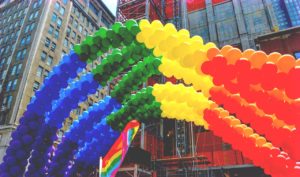Yes and No to Pride, Fifty Years after Stonewall

Fifty years after Stonewall—the historic uprising begun in response to a police raid of a gay bar in New York City that launched the gay rights movement—I can walk into my local department store and find a Gay Pride display—not in some hidden corner of the men’s department but front and center in the children’s department. Now, Pride clothes for kids are easy to come by.
Fifty years after Stonewall, the shopping cart logos for the online merchants I frequent are rainbow colored for Pride month.
Fifty years after Stonewall, I can attend “bopo (body positive) rainbow unicorn aerobics” at a local fitness studio to celebrate Pride month. This is not advertised on a flyer surreptitiously stapled to a tree or to the bulletin board at the earthy food co-op. This is advertised on the Town Events webpage run by the local government of a small, upper midwestern city where bars serve fish every Friday in Lent and where a flyer for the fire fighters’ “Pancake Breakfast on Palm Sunday” needs no further elaboration.
Fifty years after Stonewall, my own preteen, who attends a private Catholic school, will happily declare, upon getting rainbow-colored earrings at Christmas, not “Oohh, pretty!” but “Awesome, I can wear these for Pride day at school!”
Fifty years after Stonewall, before which gay intimacy was not only uncelebrated but flatly illegal in most states, we have a Pride month, Pride days, and Pride festivals in the children’s departments and in our children’s vocabulary.
I am grateful to have inherited a society after Stonewall, to have grown up in its aftermath and with its benefits, and to enjoy a society which is therefore more capacious, to borrow from Judith Butler’s Undoing Gender. Thanks to the resistance at Stonewall and elsewhere and to the LGBT rights movement, American society came to have more space for more lives. That new capaciousness is reason for Pride!
However, fifty years after Stonewall, I also notice, amid the rainbow shopping carts and the increasing normality of Pride, that some of what this movement has gained us is a domestication of LGBT lives. From children’s store displays to government recognition, we have normalized sexual possibilities that were once not considered “normal.” It’s clear we have commercialized Pride, but beyond that it also seems that in five decades of making “gay” something to be proud of, we have lost of some of the queerness of gay. As the authors of Gay Shame make clear, many expressions of sexuality don’t have much place in today’s Pride celebrations because they are considered too queer or outside of what has become “normal” gay life and pride. Queer liberation marches, competing with Pride events, are making just this point.
The authors of the 2017 War on Sex caution that, as David Halperin writes, “there is reason to temper the optimism that has greeted the dramatic success of the … (LGBT) rights movement in decriminalizing private, consensual, noncommercial adult sex and in legalizing gay marriage.” These have helped to fuel a confidence that keeps us from seeing how “sex has increasingly become a distinct target of contemporary policing, punishment, and bureaucratic management.” To illustrate, the book recounts the story of the North Carolina teen who only narrowly escaped lifelong status as a sex offender for texting a nude photo of herself to her teen boyfriend.
In other words, fifty years after Stonewall, we certainly have more acceptance of gay and lesbian couples in the U.S. The changes have made gay and lesbian family life openly possible in many communities. All in all, I’d much rather my kid and her Pride earrings go to school in a society of these domesticated LGBT possibilities. But we are still far from legal protections and societal acceptance for a full range of consensual sex. I take pause to wonder at the sexual practices that are still shunned or legally punished despite the undeniable gains of the LGBT movement. I think about sex workers, polyamorous connections, and those who simply don’t legalize their monogamous commitments through the state.
I wonder also, as I heed the wisdom of Audre Lorde and adrienne maree brown, if there is a societal loss when we domesticate the erotic. Do some of us conform to our social system in order to be accepted by it? Might we tame down some of the extravagance accessible through the erotic in order to be seen as normal families, normal people? Many of those protesting in the original Stonewall uprising were creating social space for just that extravagance and for the idea that society will hold up when spaces for a wide range of sexuality are held open.
Fifty years after Stonewall, I pause to wonder whose bars or sites of pleasure are now being raided, quietly or sweepingly, while I fill my rainbow shopping cart with sparkly workout wear for Pride aerobics. Yes and No to Pride, fifty years after Stonewall.
#
Anna Mercedes is Associate Professor of Theology and Gender Studies at the College of Saint Benedict and Saint John’s University and is ordained in the Evangelical Lutheran Church in America. She is the author of Power For: Feminism and Christ’s Self-Giving.
Counterpoint blogs may be reprinted with the following acknowledgement: “This article was published by Counterpoint Navigating Knowledge on 26 June 2019.”
The views and opinions expressed on this website, in its publications, and in comments made in response to the site and publications are those of the author(s) and do not necessarily reflect the views and opinions of Counterpoint: Navigating Knowledge, its founders, its staff, or any agent or institution affiliated with it, nor those of the institution(s) with which the author is affiliated. Counterpoint exists to promote vigorous debate within and across knowledge systems and therefore publishes a wide variety of views and opinions in the interests of open conversation and dialogue.



